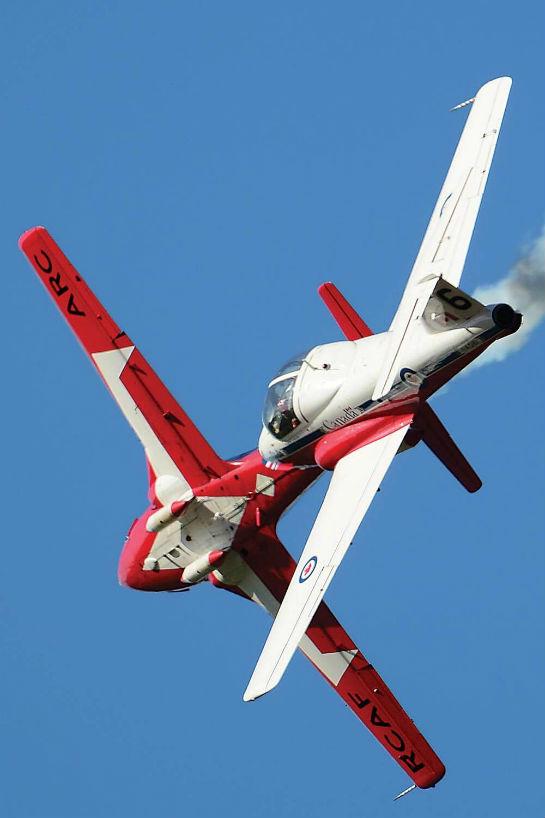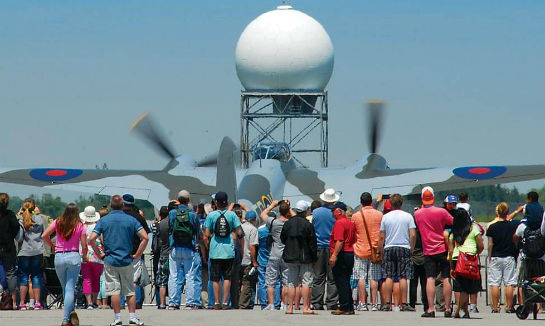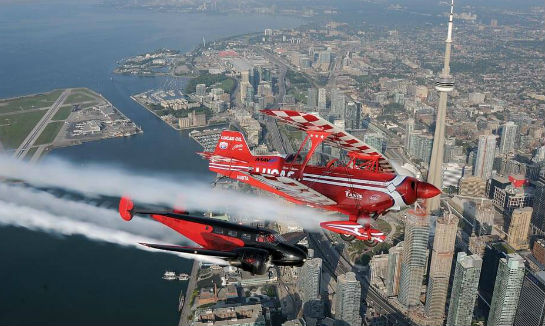Airshow safety has been a prominent topic of late. In Canada, shows must meet extensive safety requirements and regulations defined by Transport Canada in the Canadian Air Regulations. Eric Dumigan Photo
People love to watch airplanes.
That’s why airshows are one of the world’s most popular spectator events. Aviation enthusiasts will risk sunburn and dehydration to stand at an airport, sunglassed eyes scanning the skies, to watch pilots demonstrate their planes’ performance. Fast-moving and incredibly noisy military jets will make them reach down to cover their kids’ ears, and they’ll haul kilos of photo gear around to “get the shot.”
Everyone goes to an airshow because they love airplanes, even though there’s an underlying acknowledgement that sometimes, well, bad things happen.
When accidents happen, they’re both devastating and deadly. Last summer, the pilot of a vintage Hawker Hunter T7 jet trainer failed to complete a repositioning pull-out during an airshow in Shoreham, England. Eleven people on the ground died when the jet crashed, but the pilot miraculously survived.
In the wake of the accident, the U.K. Civil Aviation Authority (CAA) immediately implemented new rules regarding permitted maneuvers for vintage jets. Recently, additional rules were introduced by the CAA regarding pilot checks and airshow organizer training, along with a sharp increase in inspection fees. As a result, it’s reported that over half of this season’s airshows in Britain have been cancelled, many permanently.
From parachutists and gliders to legendary vintage aircraft and supersonic military jets, airshows rank high on entertainment value. But there’s a lot of planning to be done before show day rolls around. Eric Dumigan Photo
In Canada, 35 shows and fly-ins are planned for this year, according to the 2016 schedule from the International Council of Airshows (ICAS). All Canadian airshows must follow the extensive requirements and regulations defined by Transport Canada in the Canadian Air Regulations (CARs) Subpart 603 and Standard 623 for Special Flight Operations, Airshows. In order to put on a show, airshow organizers must have a valid Special Flight Operations Certificate (SFOC), issued by Transport Canada. Specific conditions must be met, including safe distances for spectators, emergency response, experience of key personnel, and pilot eligibility.
Creating an airshow program that’s exciting and varied is the challenge facing airshow organizers, and it can begin with finding the best of the best. “We start by hiring the most professional and highly-qualified performers in the industry,” said Jim Reith, president and CEO of the Abbotsford Airshow. Reith is an ex-RCAF CF-101 Voodoo pilot, flew with the Snowbirds, and had a decades-long airline career. “We err on the side of the folks who are not out ‘pushing the envelope’ because in this environment, the margin of safety is already low. Most of the [civilian] performers we hire hold a Statement of Aerobatic Competency (SAC) card that permits them to work down to the surface.”
Spectators marvelling at a high-g performance of the CF-18, or the formation aerobatics of the Snowbirds’ Tutors, can be forgiven for thinking that the pilots are flying to the edge of their jets’ capabilities. The RCAF’s Maj Eric Martinat explains that the Air Force has “developed our flying displays to be pleasing to the spectators, but not necessarily difficult for the pilots to perform, nor seriously push the performance envelope of the aircraft.” Based at 1 Canadian Air Division in Winnipeg, Martinat is safety pilot and narrator for the CF-18 demo team.
The RCAF has a strong safety culture that’s instilled in every team member, from the time they join the service. “The RCAF prides itself on its safety record,” continued Martinat. “The military flying orders that guide us have a large section on airshow safety, and state emphatically that: ‘Safety of the invited assembly of persons shall be the prime consideration at all times.’”
The Snowbirds’ Tutors are approaching an age where some might consider the planes to be in the “vintage” category, and the RCAF’s CF-18s, while newer, are also getting on. The pilots likely were not even born when the planes rolled off the assembly lines. Keeping those jets in great shape is critical to meeting the operational requirements of the demanding yearly airshow schedule.
Due to recently-added rules introduced by the CAA regarding pilot checks and airshow organizer training, along with a sharp increase in inspection fees, it’s reported that over half of this season’s airshows in Britain have been cancelled, many permanently. Eric Dumigan Photo
“We are fortunate to have top notch maintainers that keep our planes in tip-top shape,” said Martinat. “Pre- and post-display inspections and a computerized maintenance system run by expert technicians ensure our aircraft are ready to fly. Whether the planes are flying at home base or on the road at airshows, they get the same love from their technicians.”
The RCAF demo teams are crowd favourites, having performed for many years at shows across Canada, large and small, including the Abbotsford International Airshow, the Canadian International Air Show in Toronto, and the Atlantic Canada International Air Show, being held this year in Miramichi, N.B. For the teams, a return to a previous location streamlines pre-show procedures.
“Preparing the site for flying events means ensuring that there are clear show line markings,” said Reith. “The best are physical features such as runways or taxiways, because they need to be seen by performers such as a military jet team lead, from up to several miles distant and at relatively low level. We also park a large semi-trailer out in the centre of the field as a show centre marker.”
But there are often new locations and new airshows in the year’s schedule. For a first-time show, Martinat works closely with the organizers to ensure they understand the RCAF’s requirements. “For many locations where the Snowbirds will perform, the Snowbirds coordinators will actually fly to those locations and conduct a pre-site survey. We don’t want any surprises on airshow day.”
During the show, the air boss is charged with the responsibility of making sure that everything runs smoothly, without any surprises.
“The air boss is a bit like the conductor of the orchestra, and is responsible for the safe flight operations of an airshow,” said Reith, who has also served as air boss in Abbotsford and at other shows in North America. “The air boss briefs the performers prior to the airshow period, creates the schedule and then works the schedule either directly over the radio or through the assistance of the airport’s tower controllers. Transport Canada empowers this individual with making decisions as to whether airshow operations are safe.”
Teams have to keep a laser-like focus on every variable to ensure a safe, exciting show. Eric Dumigan Photo
“Safety is Transport Canada’s top priority,” confirmed agency spokesperson Natasha Gauthier. “The department supports events that safely showcase Canada’s innovative aviation industry, and spark interest in this important sector.”
Although an air boss isn’t a licensed position, a significant level of expertise and experience is required before an airshow would consider giving someone this critical responsibility. Reith drew on his background as a military jet pilot and aerobatic team pilot. “I also took the ICAS [International Council of Air Shows] training course, Airshows 101, which covers the gamut of operational issues involved in airshow management, and Air Boss 201, which is more specific to the air boss role,” he explained.
Every show location is different, but the Abbotsford Airshow can present an air boss with unique challenges. Trent Stenmark—a veteran air traffic controller who was the 2015 Abbotsford air boss—had to incorporate regular airline operations into the schedule. And a busy fire-fighting season could require a water bomber scramble, mid-show. “Hopefully, the water bombers are ready to go at the end of an act, and we can depart them like it’s part of the show,” he said.
No matter who’s flying, the air boss has final say on the performance. “One time, a military jet strayed inside the showline towards the crowd on his high alpha pass,” said Stenmark. “He was given a ‘knock it off, knock it off, knock it off’ call—our standard call to stop the performance—and told to land. That was the end of his performance for the day. Enforcing the showlines and protecting the crowd is job one.”
That pilot may have lost focus, but a pilot’s pre-show preparation is as individual as the people who fly, according to Martinat. “Some performers like to spend some quiet time alone and contemplate their performance, while others prefer to stay with their teammates until it’s time to strap in. It’s very personal.”
The airshow circuit can be punishing to both pilots and aircraft. Practices occur year-round, and the show season runs non-stop from April to October. Teams have to keep a laser-like focus on every variable to ensure a safe, exciting show. And the toughest part of the airshow season isn’t necessarily the continuous high-g pounding and physical demands on the pilots.
“I speak on behalf of my colleagues that the most challenging part of being an air demonstration pilot is staying focused while being away from your loved ones during the very long airshow season,” concluded Martinat. “I equate it [to] running a marathon: there are ups and downs and it’s a long haul, and the teams have to stay at the top of their games for the entire time. It’s pure endurance. The most exciting and rewarding part is showing the public your expertise flying high performance machines, and then getting to meet the airshow spectators, the kids especially, who are very grateful for the show.”
Howard Slutsken’s lifelong passion for aviation began when he was a kid, watching TCA Super Connies, Viscounts, and early jets at Montreal’s Dorval Airport. He’s a pilot who loves to fly gliders and pretty much anything else with wings. Howard is based in Vancouver, B.C.







